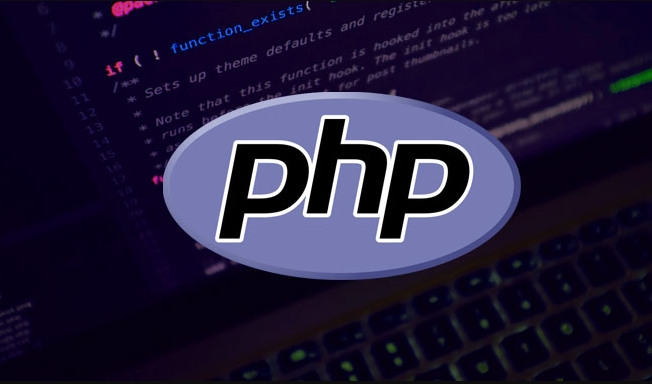In PHP, functions can be defined within an if statement, but attention should be paid to scope and repeated declaration issues. First, PHP allows the definition of functions based on conditions, which once defined, becomes globally available; secondly, if and else blocks try to define functions with the same name and are executed, a fatal error will be caused; finally, to avoid conflicts, function_exists() should be used to check whether the function is defined. Although feasible, for maintainability and code clarity considerations, it is recommended to prioritize other methods of handling conditional logic.

Yes, you can define a function inside an if statement in PHP — but with a catch.

PHP allows conditional function definitions, which means you can define functions based on certain conditions. However, doing it inside an if block directly might not always work the way you expect, especially if you're used to how other languages ??handle scope and function declarations.

How to Define a Function Inside an If Statement
You can define a function inside an if block, like this:
if ($someCondition) {
function myConditionalFunction() {
echo "This function was defined conditionally.";
}
} But here's the important part: once that function is defined, it's available globally , even outside the if block. PHP doesn't restrict the scope of the function to where it was defined — it just checks whether the function exists before defining it again.

So if the condition evaluates to true , the function becomes globally accessible from that point onward.
Why You Might Want to Do This
There are valid use cases for defining functions conditionally:
- You want to load different versions of a function depending on environment or configuration.
- You're working with legacy code or plugins that may or may not be active.
- You're trying to optimize performance by only defining a function when needed (though this isn't always a big win).
For example:
if ($useLegacyMode) {
function processData($data) {
return oldProcessingMethod($data);
}
} else {
function processData($data) {
return newImprovedProcessing($data);
}
} This lets you dynamically choose which version of processData() to use at runtime.
What You Need to Watch Out For
The main gotcha is that you can't redeclare the same function more than once during execution. So if your if and else blocks both try to define the same function and both get executed, you'll get a fatal error.
For example:
if (true) {
function test() { echo "A"; }
} else {
function test() { echo "B"; } // Fatal error!
} In this case, since the if block runs, test() is already defined. The else block tries to redefine it, which causes a crash.
To avoid this, you can check if the function already exists using function_exists() :
if (!function_exists('myFunction')) {
function myFunction() {
echo "Defined only once.";
}
}That way, even if multiple branches attempt to define the function, only the first one successes.
When It's Better Not To Do This
While it's possible, defining functions conditionally isn't always a best practice:
- It can make debugging harder — especially if the function appears to come out of nowhere later in the script.
- It breaks the expectation that functions are declared up front.
- It can cause conflicts in larger applications or when working with others.
Instead of defining functions inside if statements, consider alternatives like:
- Using classes and methods with conditional logic
- Returning different anonymous functions (closures) based on conditions
- Defining all functions normally and calling them conditionally
So yes, you can define a function inside an if statement in PHP, and sometimes it makes sense. But be aware of scoping rules, redclaration risks, and maintenance concerns.
Basically that's it.
The above is the detailed content of Can you define a function inside an if statement in PHP?. For more information, please follow other related articles on the PHP Chinese website!

Hot AI Tools

Undress AI Tool
Undress images for free

Undresser.AI Undress
AI-powered app for creating realistic nude photos

AI Clothes Remover
Online AI tool for removing clothes from photos.

Clothoff.io
AI clothes remover

Video Face Swap
Swap faces in any video effortlessly with our completely free AI face swap tool!

Hot Article

Hot Tools

Notepad++7.3.1
Easy-to-use and free code editor

SublimeText3 Chinese version
Chinese version, very easy to use

Zend Studio 13.0.1
Powerful PHP integrated development environment

Dreamweaver CS6
Visual web development tools

SublimeText3 Mac version
God-level code editing software (SublimeText3)

Hot Topics
 What are some best practices for versioning a PHP-based API?
Jun 14, 2025 am 12:27 AM
What are some best practices for versioning a PHP-based API?
Jun 14, 2025 am 12:27 AM
ToversionaPHP-basedAPIeffectively,useURL-basedversioningforclarityandeaseofrouting,separateversionedcodetoavoidconflicts,deprecateoldversionswithclearcommunication,andconsidercustomheadersonlywhennecessary.StartbyplacingtheversionintheURL(e.g.,/api/v
 How do I implement authentication and authorization in PHP?
Jun 20, 2025 am 01:03 AM
How do I implement authentication and authorization in PHP?
Jun 20, 2025 am 01:03 AM
TosecurelyhandleauthenticationandauthorizationinPHP,followthesesteps:1.Alwayshashpasswordswithpassword_hash()andverifyusingpassword_verify(),usepreparedstatementstopreventSQLinjection,andstoreuserdatain$_SESSIONafterlogin.2.Implementrole-basedaccessc
 What are the differences between procedural and object-oriented programming paradigms in PHP?
Jun 14, 2025 am 12:25 AM
What are the differences between procedural and object-oriented programming paradigms in PHP?
Jun 14, 2025 am 12:25 AM
Proceduralandobject-orientedprogramming(OOP)inPHPdiffersignificantlyinstructure,reusability,anddatahandling.1.Proceduralprogrammingusesfunctionsorganizedsequentially,suitableforsmallscripts.2.OOPorganizescodeintoclassesandobjects,modelingreal-worlden
 What are weak references (WeakMap) in PHP, and when might they be useful?
Jun 14, 2025 am 12:25 AM
What are weak references (WeakMap) in PHP, and when might they be useful?
Jun 14, 2025 am 12:25 AM
PHPdoesnothaveabuilt-inWeakMapbutoffersWeakReferenceforsimilarfunctionality.1.WeakReferenceallowsholdingreferenceswithoutpreventinggarbagecollection.2.Itisusefulforcaching,eventlisteners,andmetadatawithoutaffectingobjectlifecycles.3.YoucansimulateaWe
 How can you handle file uploads securely in PHP?
Jun 19, 2025 am 01:05 AM
How can you handle file uploads securely in PHP?
Jun 19, 2025 am 01:05 AM
To safely handle file uploads in PHP, the core is to verify file types, rename files, and restrict permissions. 1. Use finfo_file() to check the real MIME type, and only specific types such as image/jpeg are allowed; 2. Use uniqid() to generate random file names and store them in non-Web root directory; 3. Limit file size through php.ini and HTML forms, and set directory permissions to 0755; 4. Use ClamAV to scan malware to enhance security. These steps effectively prevent security vulnerabilities and ensure that the file upload process is safe and reliable.
 What are the differences between == (loose comparison) and === (strict comparison) in PHP?
Jun 19, 2025 am 01:07 AM
What are the differences between == (loose comparison) and === (strict comparison) in PHP?
Jun 19, 2025 am 01:07 AM
In PHP, the main difference between == and == is the strictness of type checking. ==Type conversion will be performed before comparison, for example, 5=="5" returns true, and ===Request that the value and type are the same before true will be returned, for example, 5==="5" returns false. In usage scenarios, === is more secure and should be used first, and == is only used when type conversion is required.
 How can you interact with NoSQL databases (e.g., MongoDB, Redis) from PHP?
Jun 19, 2025 am 01:07 AM
How can you interact with NoSQL databases (e.g., MongoDB, Redis) from PHP?
Jun 19, 2025 am 01:07 AM
Yes, PHP can interact with NoSQL databases like MongoDB and Redis through specific extensions or libraries. First, use the MongoDBPHP driver (installed through PECL or Composer) to create client instances and operate databases and collections, supporting insertion, query, aggregation and other operations; second, use the Predis library or phpredis extension to connect to Redis, perform key-value settings and acquisitions, and recommend phpredis for high-performance scenarios, while Predis is convenient for rapid deployment; both are suitable for production environments and are well-documented.
 How do I perform arithmetic operations in PHP ( , -, *, /, %)?
Jun 19, 2025 pm 05:13 PM
How do I perform arithmetic operations in PHP ( , -, *, /, %)?
Jun 19, 2025 pm 05:13 PM
The methods of using basic mathematical operations in PHP are as follows: 1. Addition signs support integers and floating-point numbers, and can also be used for variables. String numbers will be automatically converted but not recommended to dependencies; 2. Subtraction signs use - signs, variables are the same, and type conversion is also applicable; 3. Multiplication signs use * signs, which are suitable for numbers and similar strings; 4. Division uses / signs, which need to avoid dividing by zero, and note that the result may be floating-point numbers; 5. Taking the modulus signs can be used to judge odd and even numbers, and when processing negative numbers, the remainder signs are consistent with the dividend. The key to using these operators correctly is to ensure that the data types are clear and the boundary situation is handled well.






